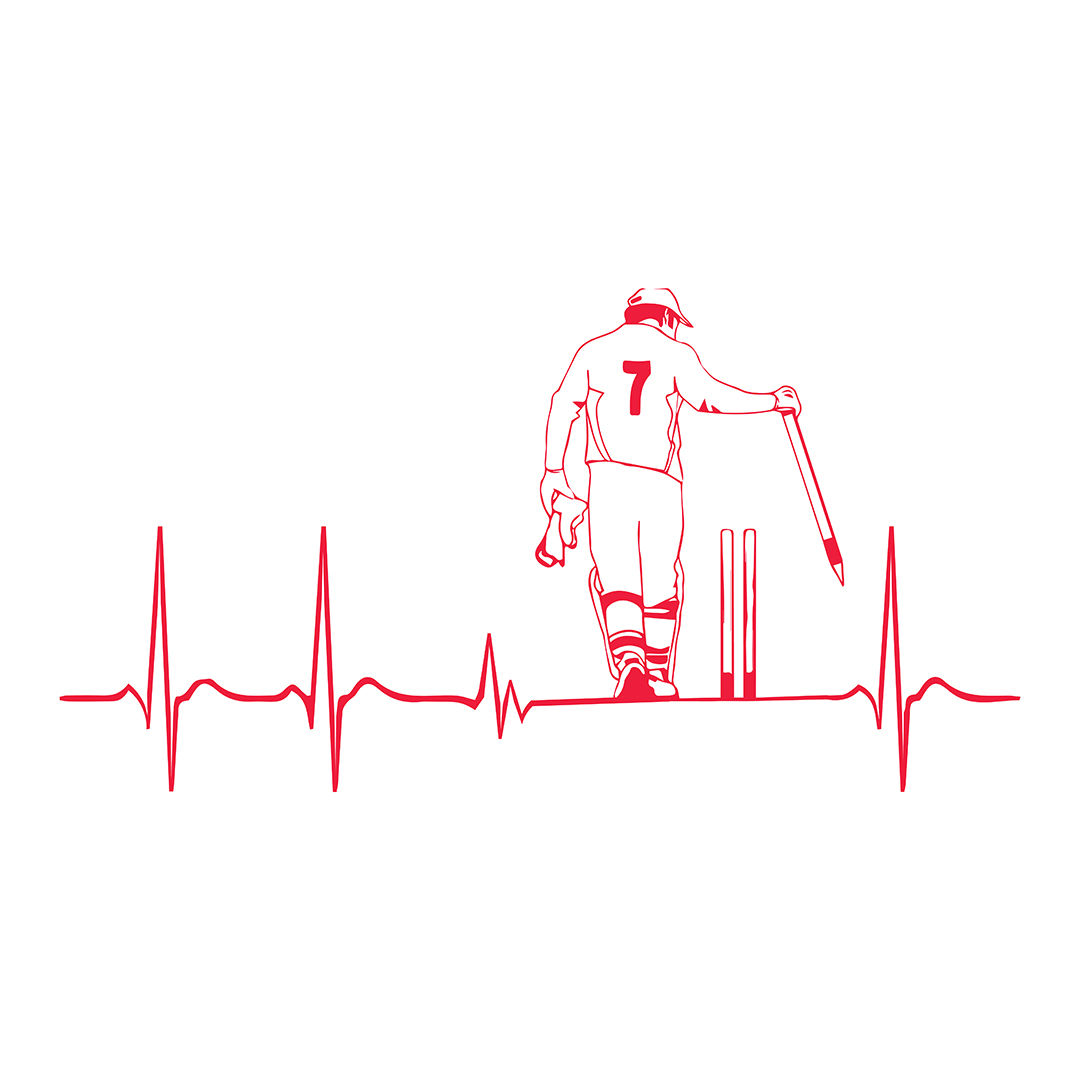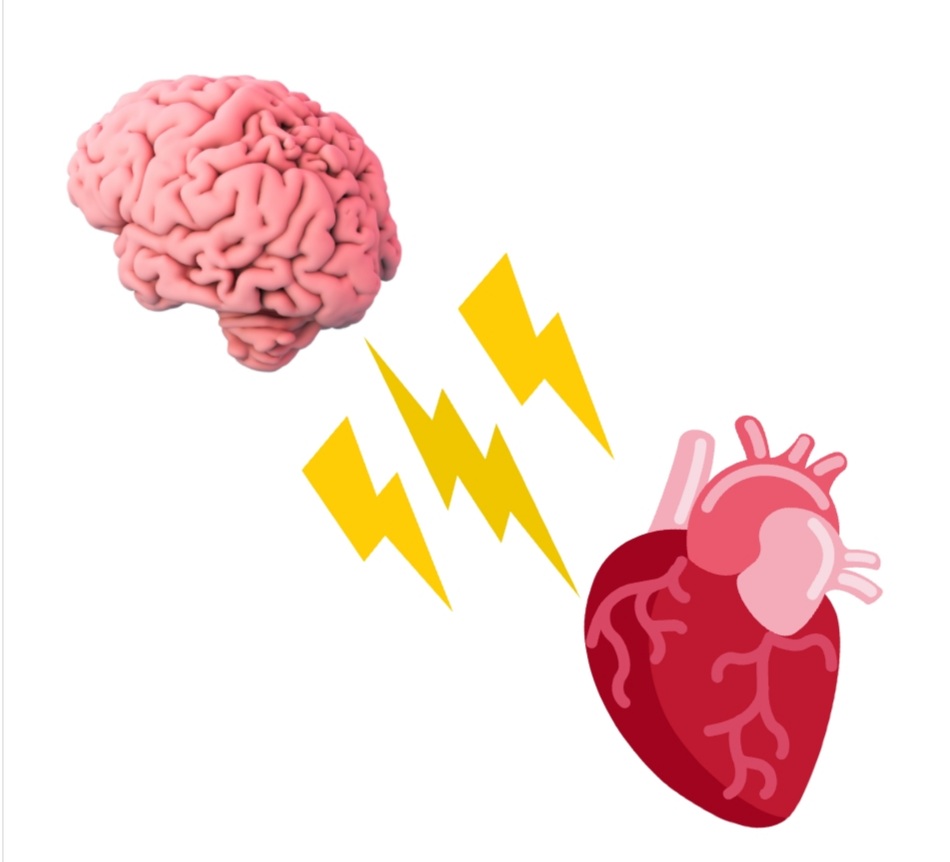It's not infrequent that we hear from our friends and family members saying "I literally got a heart attack watching that match" particularly a thriller or a high profile game with a lot of expectations and a nail biter.

Is it a fact or fiction ? Let's explore scientifically
Normally , our body functions in a well coordinated manner controlled primarily by nervous system and endocrine system
Heart is innervated by autonomic nervous system both sympathetics and parasympathetics.Sympathetics is more and more concerned with Flight/Fight response in periods of acute stress,which is necessary for survival. Parasympathetics calms down the body, for rest, digestion and repair which is a basal state to keep the body in harmony.
Sympathetics increase heart rate and cardiac output and are augmented by adrenal hormones secreted in times of stress.

Emotional stress is a well-known trigger of acute coronary syndromes.The increased sympathetic drive is generally considered a dangerous chronic condition in patients with occult or known coronary artery disease.
Emotional stress is driven to our brain by the peripheral sensitive apparatus eliciting a complex reflex including central and autonomic nervous systems with sympathovagal recruitment and adrenal stimulation with increasing catecholamine plasmatic concentration. The final effect of rising blood pressure, tachycardia , sweating , and peripheral vasoconstriction.

When one is emotionally attached to cricket match, in terms of nationality, he gets deeply connected that the sympathetic system is several times more and more activated to increase the heart rate and cardiac output that for few minutes he may feel the pounding heart in the close context.He may experience the same level of stress which the player experiences in the field just by watching the broadcast.The basic difference is the player is fit physically to endure the amount of stress involved in a game because of increased cardiovascular reserve and collateral circulation which come into play to tackle the inadvertent situations whereas the normal ordinary men in the middle age & old age , most of them being metabolically unhealthy with poor cardiovascular reserve and poor collateral circulation.
If the coronary circulation is blocked by atherosclerotic plaque , it is manifested by symptoms of chest pain during physical exertion which is otherwise unrevealing during normal day to day activities.This is what we call stable angina.Our Indian sub-population is having poor cardiovascular health because of poor nutrition and sedentarism, even our former Indian Skippers like Kapil Dev & Savrou Ganguly are not exemption who suffered from heart attacks and underwent angioplasty.
We always have heard in the news about tens of heart attacks and unprecedented deaths while watching cricket matches particularly between India & Pakistan. When it is a close contest between the two sides, the nervousness is increased several fold.In India cricket is a sensation and not just a game of bat & ball. For people with normal cardiovascular reserve, it is not much of a problem tackling the sympathetic overdrive. But for people with compromised cardiovascular reserve , particularly the old aged and middle aged-increased sympathetic stimulation during excitement increases heart rate by 2-3 times that of normal, with heart pounding fast. It can cause discrepancy i.e., increased demand in cardiac work vs poor increase in blood supply demand.It can cause myocardial ischemia when sustained for a considerable time can finally trigger heart attacks with poor outcome.Coronary spasms occur most commonly in smokers , insulin resistance & emotional stress.
Heartbreak and broken heart are popular definitions of sudden cardiac death related to grief.
In patients with chronic coronary artery disease, the so-called “vulnerable patients” with multiple risk factors such as metabolic syndrome, active smoke, hypertension and diabetes the emotional stress can elicit a catecholamine direct toxic effect on a vulnerable plaque in the coronary artery tree leading to vessel occlusion.
Also, short-term severe stressful situations often can cause severe but usually temporary heart failure. This condition is called broken heart syndrome, also known as takotsubo cardiomyopathy, apical ballooning syndrome or stress cardiomyopathy
Cricket is a game to be enjoyed in a sportive manner just like any other sport.
High Emotional attachment is unnecessary and unwanted ones : love cricket ; play cricket & watch cricket but you should be grounded to reality. It is never a matter of life and death. Know your purpose in your life.Media hypes it for their commercial purpose !!!
There are a lot of things going on in Cricket in terms of politics, Corporates and entertainment sectors which become more and more evident during IPL matches being played every year.
“ Give them bread and circuses and they will never Revolt”. The modern day circuses are the IPL cricket and T20s.
Roman’s Colosseum: The era of Gladiators


Cricket stadium : The Modern day Colosseum
The evil was not in bread and circuses per se, but the willingness of the people to sell their rights as free men for full bellies and the excitement of the games which the other human hungers which bread and circuses can never appease.
In a political context, the phrase means to generate public approval , not by excellence in public service or public policy, but by diversion, distraction , or by satisfying the immediate or base requirements of a populace, by offering them a palliative : for example food ( bread ) or entertainment ( circuses ). It is particularly relevant to the current Indian Political system.
It’s possible that stress reduction exercises might calm down the mechanism that converts stress to heart attacks and strokes.
In fact, stress reduction tactics—like increasing your physical activity, practicing mindfulness, deep breathing, even seeing a funny movie— reduce both the size and activity of the amygdala, while having beneficial impacts on other brain tissue, too. So do your heart a solid by calming your racing mind.
Increase physical exercise.
Find an exercise regimen that works for you. This can include daily walks or riding a bicycle. Start slow and gradually lengthen these regimens over time.
Practice relaxation exercises.
Incorporate muscle relaxation techniques, such as breathing exercises, to deal with anxiety and stress into your daily routine.
Make a connection to your spirituality.
Spirituality helps to give your life a clearer purpose and a greater connection to the world and others. It's not necessarily connected to a specific belief system or even religious worship. Try prayer, meditation or keep a journal to express your feelings and focus your attention.
Seek professional help.
Get an annual physical and talk to your health care provider about your health, including psychosocial stress.
* Eat a healthy diet
* Avoid added sugars, refined oils , trans fats, and highly refined carbs
* Limit alcohol- it acts a toxin and hence no safer upper limit
* Stop smoking.
* If you smoke, plan to quit.
* Monitor your heart health.
* Know your numbers for blood pressure, blood glucose and cholesterol.
The modern world is rife with stresses, distractions and physical challenges that people encounter on an everyday basis. The rapid advances in technology over the last 200 years have made our lives more comfortable in many ways but have also taken away from us the physical activity that our ancestors used to experience on a daily basis.
Add to this the pressures of day-to-day existence in the 21st century, we find that the comfort that modern life has lured us into comes at a cost: a plethora of mental and physical disorders ranging from anxiety and stress to hypertension, diabetes and cardiac issues. In this context, the relevance of Yoga has become even more pronounced.
Yoga is an ancient Indian practice that has been around for over 5000 years. It is a holistic approach to physical, mental and spiritual wellness that focuses on the integration of the body, mind, and soul. In the modern world, Yoga has gained immense popularity as a way to manage these stresses, while helping to improve physical fitness and improve overall health.
Yoga teaches us to lead a healthy life. It improves creativity, concentration and sharpens our memory. In the hustle and bustle of modern life, it is natural for our emotional stability to decline. Yoga is a great way to prevent this while also improving our stamina, muscle strength and mental stability.

The modern world has made everyone seek instant gratification. Moreover our body and mind are hacked by the Big Corporates by hijacking the Dopaminergic overdrive mainly by confusing the pleasure with happiness like happy meals, happy hours etc. making us addictive, unhappy and sick. In the pursuit of pleasure, we lose happiness. Most of us are either in aggression or depression but not grounded to reality. Corporates and the westernization of our society are creating an illusion and our perception is altered and we are far off from real values and ethics."The World has got enough for everyone's needs but not for someone's greed !!" Instant weight reduction, instant relaxation and instant energization are sought by many. While this is a bane of modern life, Yoga can be beautifully blended into this fast-paced world to help us achieve our goals. There are many types of Pranayamas (Heating Pranayama and balancing Pranayama) and Asanas (twists , arm balances) that can actually help us rejuvenate ourselves quickly once we learn the right technique! Let us explore the various benefits of yoga, and how it can help individuals control their mind and body in today's fast-paced world.
The practice of yoga has been shown to have a positive impact on mental health and well-being. It can help to reduce stress, anxiety, depression, help a person relax, and improve overall mood.
Stress is one of the biggest mental health challenges faced by people in the modern world. The fast-paced lifestyle and constant demands of daily life can take a toll on an individual's mental well-being, leading to chronic stress and anxiety. Yoga provides a powerful tool for managing through the practice of mindlessness ( living to the moment and the ultimate emptiness ) and meditation. The combination of controlled breathing, mindlessness and physical movement can help to reduce the levels of the stress hormone cortisol, leading to a reduction in stress levels. Amygdala, the emotional sentinel in our brain hijacks the prefrontal cortex during times of stress. 'Low on emotions' state keeps us in a calm and composed state even at adversity enabling us to handle stress properly. High on emotions literally hijacks the thinking capacity of the cortex and reflexive decisions are made from the hindbrain which often go wrong making us distressed. It is worthwhile to note that we should never make decisions when you feel distressed. It is wise to have high Emotional IQ

 Additionally, yoga includes a variety of postures or “asanas” that have been specifically designed to promote relaxation and reduce stress. For example, the downward-facing dog pose, known as Adho Mukha Svanasana, is an excellent yoga pose for reducing stress and anxiety. By stretching and contracting the body in specific ways, yoga helps to release pent up tension and promote a sense of relaxation.
Additionally, yoga includes a variety of postures or “asanas” that have been specifically designed to promote relaxation and reduce stress. For example, the downward-facing dog pose, known as Adho Mukha Svanasana, is an excellent yoga pose for reducing stress and anxiety. By stretching and contracting the body in specific ways, yoga helps to release pent up tension and promote a sense of relaxation.
Through the practice of yoga, individuals learn to focus their awareness on one particular thought in the mind and be present in the moment, which can help reduce stress and anxiety. In yoga, individuals use controlled breathing techniques and body movements to bring the mind into a state of calm and relaxation. By doing this, they can shift their focus away from the stressors of daily life and find inner peace.
Awareness is a mental concept that allows us to be more present in the world around us and is a very important part of Yoga. Awareness is a glow of light illuminating the part of the mind which we wanted to focus. Where is mind ? Never mind !! It's not definitely in the brain but rather the universal consciousness. Brain is like an antenna for perceiving the broadcast. There should be awareness in the postures, in the feeling of the stretches and observation of the breath. This is when the practice becomes more beneficial. Each time we practice experiencing a posture with awareness, the gift of the posture keeps on getting enriched and we experience growth in our practice.
Awareness is not about only doing an asana. It is a very good ego boost. Each session of pranayama practiced with awareness increases our experience of sensitivity and expands our awareness. Awareness is the essence of Yoga. Being aware of our current emotion, without being judgmental about it is the same as Yoga.
One of the primary benefits of yoga is the ability to bring about a deep sense of relaxation. Basically, Vagal tone is strengthened in many different ways through breathing techniques thereby one continues to stay in parasympathetic dominant mode (the natural state) except for acute emergencies (flight or fight response - Sympathetic dominance for protection) helps people to stay grounded to reality. Through the practice of yoga, individuals can release tension in both their mind and body, reducing feelings of stress and anxiety. In addition to the physical movements and breathing techniques, the focus on mindfulness and being present in the moment can help individuals achieve a deeper level of relaxation.
Anxiety is a common mental health concern in the modern world. We are living in a world of Sympathetic dominance; the very reason for many of the diseases of modern-day civilization. Interestingly, such derangement is often emotional rather than physical causes. The practice of yoga can help to reduce anxiety by promoting relaxation and reducing the levels of stress hormones in the body. By focusing on the present moment and controlling the breath, individuals can learn to calm their minds and reduce feelings of anxiety.
Every time life takes you on a roller coaster ride, just ‘Pause’ for a moment! Be a witness to the situation without any attachment or aversion, instead of clinging to it. This gives a clear perspective of the situation, and this is what mediation teaches us.
Depression is a serious mental health condition that affects millions of people worldwide. While yoga is not a cure for depression, it can help to manage symptoms and improve overall mood. The combination of physical activity and mindfulness can help to increase the production of feel-good hormones, such as serotonin and dopamine, leading to improved mood and reduced symptoms of depression.
Yoga is often seen as a form of physical exercise that combines controlled breathing, postures (asanas), and meditation. The physical aspect of yoga is aimed at improving flexibility, strength, balance, and overall health.

The practice of yoga involves a range of movements and postures that help to stretch and strengthen the muscles, tendons and ligaments, thereby improving flexibility and range of motion. Over time, a regular yoga practice can increase flexibility and reduce the risk of injury, especially for individuals who spend a lot of time sitting or have sedentary lifestyles.
Many yoga postures require individuals to hold their own body weight, which can help to build strength in the muscles, especially in the arms, legs, and core. This can be particularly beneficial for individuals who are looking to improve their overall fitness level. For example, the warrior pose, or Virabhadrasana, is an excellent yoga pose for building strength in the legs, arms, and core. Yoga is not only for flexibility or aerobics, but it could improve muscle building and strength through anaerobic or weight bearing strength training.
By practicing yoga regularly, individuals can also improve their overall body tone. The combination of stretching, holding poses, and controlled breathing can help to tone and sculpt the muscles, leading to a more toned and defined physique. In a world moving towards sedentarism with high prevalence of Sarcopenia ( muscle loss ) Osteopenia ( bone loss ) mainly attributed to the disuse atrophy, hence preserving them is so vital for preventing chronic ailments.
In yoga, balance is not just physical but also mental and spiritual. Through the practice of yoga, individuals can improve their balance both on and off the mat. This can help to reduce the risk of falls, especially among the elderly, and improve overall posture and alignment.It is worth to remember that the most common reason for morbidity and mortality among elderly is falls & fractures.
Yoga is not just a physical practice but also a spiritual one. The word ‘yoga’ means ‘union’ and is meant to bring about a sense of unity between the individual and the universe. The spiritual aspect of yoga is focused on the development of awareness and consciousness, leading to a deeper sense of connection and purpose.

Through the practice of yoga, individuals can develop a greater sense of self-awareness. This involves being mindful of the thoughts, emotions, and physical sensations that are experienced in the present moment. By developing self-awareness, individuals can gain a better understanding of their own needs and desires, leading to a deeper sense of purpose and fulfillment.
We always tell our kids to concentrate particularly on their studies. But we ourselves have no idea what concentration is ? and the methods to concentrate !! Concentration is the ability to keep your focus on a particular thought.The ability to stay concentrated for a longer time is the willpower.Willpower is like mental biceps !! Yoga helps you to focus , to concentrate and increase your willpower when practiced regularly on a daily basis.
" Wherever attention goes, your energy flows " & ultimately power manifestation happens turning them into reality. The problem is we never where to focus ? In order to find where to focus, we should know the purpose in your life. Each & every human is gifted a specific ability to perform a single task at the very best of human possibility !!! This would definitely give us the path to find the purpose in our life. Boredom will never occur if you synchronize yourself with the purpose in your life.

The practice of yoga can also help to develop a deeper sense of connection to the universe. This involves a sense of interconnectedness with all living things and a deeper understanding of the interdependence of all things. By developing this sense of connection, the practice at Yoga helps to realise the ultimate truth and to be at peace with oneself.
The ancient practice of Yoga continues to be more relevant than ever in the modern world. By combining physical movements, breathing techniques, and mindfulness, Yoga offers individuals a powerful tool for controlling their mind and body. Whether you are looking to reduce stress and anxiety, increase flexibility, muscle strength, and body tone, or simply find inner peace, Yoga has something to offer for everyone.
The modern world is filled with noise, distractions and multiple forms of stimuli. Noise, whether external or internal, is a part of our daily existence, and practising Yoga amidst it brings us back to the present moment and helps us stay focused. Embrace Yoga amidst all the noise and find your inner peace regardless of where you are!
